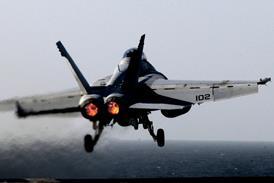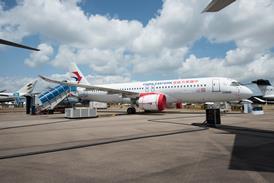Guy Norris/LOS ANGELES
As he trundles across the Mojave Desert, the driver has no idea that his truck has been detected by the radar as a "mover". More than 70km (43 miles) away, and 27,000ft (8,200m) up, the HISAR operator switches to spot mode and places his cursor over the 18-wheeler, which is reflecting more than enough energy to be outlined clearly by the Hughes X-band synthetic-aperture radar (SAR).
"Got him!" says HISAR business-development manager Justin Monger. Satisfied with the snapshot data from the spot mode, the operator switches the radar to strip mode. Within moments, Mojave Airport hoves into view on the display, with its runways appearing black against the lurid green radar image of sage and sand. Another "spot" is selected and, in less than 60s, a bright image appears which shows three easily identifiable Boeing 747s and a Lockheed L-1011 arranged nose-to-tail on a taxiway. With this picture "in the bag", the radar is switched back to wide-area moving-target-indicator (WAMTI) mode to scan more than 10,000km2 (3,800 miles2) of desert and mountain in less than 1min.
The fast-paced switching between modes was conducted during engineering test flights of the Hughes Integrated Surveillance and Reconnaissance System, or HISAR, as it was prepared for a world tour which is expected to take in 20 countries over ten months. Flight International joined one of the pre-tour tests of the HISAR, which is mounted in a Raytheon Beech Super King Air 200 for the demonstration tour that began with an international debut at the Paris air show.
The tour is of vital importance to Hughes, which has teamed with Raytheon (as supplier of the platform) to capitalise on years of development work on SAR and to provide an "affordable" real-time airborne reconnaissance and surveillance system. At the core is the X-band radar, which has been developed at low cost by using commercial off-the-shelf (COTS) hardware and a standard high-order software language. Despite its COTS make-up, the HISAR is closely related to systems fielded by the US Air Force in the Lockheed U-2R, and by the US Army in the de Havilland RC-7B "Crazy Hawk" surveillance aircraft. Flight tests of another variant are scheduled to begin in 1998 on the Teledyne Ryan Tier II Plus Global Hawk unmanned air-vehicle.
Ideal policing tool
Hughes believes that the relatively cheap, but highly capable, surveillance system will make the HISAR an ideal policing tool for nations, particularly in the Asia-Pacific region, which are facing growing numbers of illegal border crossings. The stand-off capability of the HISAR is also intended to detect threatening force build-ups along a border.
A key element is the embedded global-positioning-system (GPS) receiver, which is combined with the aircraft's inertial-navigation system (INS) to send aircraft attitude, position and velocity to a processor control unit (PCU). This in turn sends aircraft position data back to the operator's workstation. A combination of GPS and INS is vital to system fidelity "-because we need to know aircraft attitude, pitch and yaw with extreme accuracy for the obvious effect it has on the radar image", says Monger. The system needs signals from four GPS satellites for accuracy, but normally tracks a fifth satellite as a "hot back-up."
The mission-planning software monitors and displays aircraft location and automatically directs the radar to collect preplanned "scenes". The operator can modify the collection plan, and can also use the processed-image display to designate and command high-resolution spot scenes. "Say, if in WAMTI mode, we see a bunch of 'movers' where I don't expect them, then we can move to spot or strip mode to immediately check it out," says Monger.
The PCU is a vital cog at the centre of the HISAR wheel as it not only sets the mode-dependent timing and control parameters, but also accepts the navigation data as well as continuously computing the dynamic motion commands required for processing and antenna pointing. The antenna, housed in a shallow dish below the belly, is stabilised in elevation and azimuth using a Hughes-designed gimbal and servo having both position and gyro feedback loops. For ground moving-target-indicator (MTI) modes, the antenna includes an azimuth monopulse channel.
As would be expected for a radar with such a variety of modes, the HISAR pulse-repetition frequency (PRF), pulse width, analogue-to-digital converter sampling rates and range-gate sampling intervals are programmable. The incoming sampled radar data are stored in a large high-speed buffer for processing before being passed to the signal processor, where it is compressed in range and azimuth. The resulting imagery is then sent to the workstation display. The images are much larger than the display format, which lets the operator either collapse the imagery for a full-scene view or roam over the whole image at full resolution.
Operating Modes
The HISAR operates in three main overland, coastal and sea-surveillance modes, with a fourth dedicated to standard sea surveillance. "The best for border applications is WAMTI because it has the longest range and the widest coverage," says Monger. Based on a typical flight profile of 200kt (370km/h) at 30,000ft, the system has detection radial velocities ranging from 10km/h to 72km/h and a range of 30-120km at ±45¼ from the flightpath.
The wide-area-search element of the WAMTI mode uses a low-PRF radar waveform and Doppler beam-sharpening, using a fixed array-length, to collect data over a wide angular range. The MTI mode is interleaved with the wide-area search to provide an overlay for activity detection, and the combination is converted and displayed as a Cartesian image. "With a map underlay we can choose all sorts of terrain features, or even streets," says Monger. "Terrain data is vital because of the shadowing effect it can have." The system automatically warns when the planned radar "scene" will have areas obscured by terrain masking.
Strip mode with MTI allows the operator to scan a continuous, 37km-wide, ribbon of territory. The strip is repositionable from 20km to 110km to one side of the aircraft, and the radar collects images with a 6m resolution. An 18.5km-wide strip can be scanned if the range is less than 37km, and a limited amount of "squint" (slewing the antenna to ±15¼) is also possible, to look either slightly ahead or behind.
As much as 13,700km2/h can be covered using this mode, which Hughes says is the most demanding on the processor. This is because data processing must keep pace with the airborne collection rate. Adding to the demand is the MTI mode, as the waveforms are different for both. The wide-area strip mode uses a low-PRF waveform while the MTI mode uses multiple PRFs. The MTI overlay with strip mode was in final check-out at the time of Flight International's visit.
Spot mode is akin to putting a magnifying glass on the area of interest. With a 1.8m resolution, spot mode can focus on a target anywhere from 20km to 110km from the aircraft. The spot itself measures 4.9km in range and between 1.1km and 2.8km in azimuth, an increase on the planned 2.5km by 2.5km box, because of the increased signal-processing power needed for the continuous strip mode and therefore also available for spot image-processing. To compensate for azimuth phase errors, which can creep in on very-long-range spot scans, the HISAR has autofocus algorithms.
Sea-surveillance mode, in sea state three, offers the capability to detect targets of up to 5m2 at 50km, and 250m2 at up to 200km. Azimuth scan is selectable to 300¼ and the maximum range is 200km. "For maritime patrol, both WAMTI and strip modes are applicable, but on top of that we have a sea-surveillance mode in flight test right now," says Monger. This capability was expected to be ready for the international tour.
HISAR suite
The HISAR is more than just an airborne radar, a view reflected by the revised acronym, which previously stood for Hughes Integrated Synthetic Aperture Radar. Although the X-band radar lies at the heart of the sensor suite, other parts of the extended system include electro-optical/infra-red (EO/IR) sensors, electronic warfare (EW) and electronic support-measures (ESM) systems as well as a sophisticated airborne datalink.
Hughes also provides many of these extras, including a dual-band EO/IR sensor, the DB-110, derived from the system used on the Lockheed U-2. The DB-110 can be operated in 0.5-1 micro-m visible spectrum using a charge-coupled-device detector array, and from 3-5 micro-m in the IR spectrum. The system, engineering-development flight trials of which began in December 1996, can operate at focal lengths of 2.8m (110in) or 1.4m for both EO and IR bands. Hughes is also offering a forward-looking infra-red (FLIR) subsystem for the basic HISAR. Based on its AAQ-16 FLIR-turret family, the second-generation system has three fields of view, with a 2:1 electronic zoom in the narrowest, plus a gimbal accuracy of 25Áradians.
A host of other companies are also prospective suppliers, including Delfin Systems, which offers a communications/intelligence subsystem based on its MA-445 antenna and MD-440 processor. Dassault Electronique is the "preferred" EW subsystem supplier and is providing its ESM-L8 antenna array and processing unit. The system has a threat library containing 15,000 emitter modes and 500 radars or platforms. It has a frequency coverage of 2-18GHz and bearing accuracy of 5¼.
Conscious of the HISAR's potentially hostile operating environment, the aircraft is also being offered with self-protection systems. These include the Northrop Grumman AAR-54 passive missile-approach warning system and the Vicon 78 chaff/flare dispenser. The high-speed (10.7Mb/s) datalink is provided by California-based Broadcast Microwave Service.
The full suite will be put to the test in locations ranging from Dubai to Kuala Lumpur and Singapore in the coming months.
Source: Flight International

















